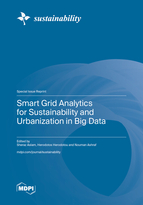Smart Grid Analytics for Sustainability and Urbanization in Big Data
A special issue of Sustainability (ISSN 2071-1050). This special issue belongs to the section "Sustainable Urban and Rural Development".
Deadline for manuscript submissions: closed (28 February 2023) | Viewed by 35636
Special Issue Editors
Interests: smart grids; data analytics; sustainable energy generations; intelligent transportation systems; sea transportation
Special Issues, Collections and Topics in MDPI journals
Interests: smart grids; data analytics; data-intensive computing; data processing systems
Special Issues, Collections and Topics in MDPI journals
Special Issue Information
Dear Colleagues,
IoT devices are found in various parts of the smart grid, such as smart appliances, smart meters, and substations. These IoT devices generate petabytes of data, which are known to be one of the most scalable properties of a smart grid. Without smart grid analytics, it is difficult to make efficient use of data and to make sustainable decisions related to smart grid operations. With the energy system of the developing world heading towards smart grids, there needs to be a forum for analytics that can collect and interpret data from multiple endpoints. Data analytics platforms can analyze data to produce invaluable results that lead to many advantages, such as operational efficiency and cost savings. However, the state-of-the-art approaches developed to achieve the above-mentioned advantages, sustainable operations of the smart grid, and the urbanization of big data are still immature. Most of these approaches have a high computational cost, as they employ conventional tools for data analytics. To overcome this challenge, novel and elegant approaches are required to cope with the big data produced from smart devices in the smart grid environment. In this context, this Special Issue aims to publish novel research work and visionary reviews on advanced smart grid analytics technologies, algorithms, case studies, and their associated applications in the smart grid, power grid modernization, and smart energy trading systems.
Topics of interest include, but are not limited to, the following:
- Smart grid analytics for urbanization in big data
- Smart grid analytics for energy system planning
- Smart grid analytics for sustainable operations and control
- Smart grid analytics for emerging applications such as Vehicle to Grid (V2G)
- Smart grid analytics for renewable energy power prediction and integration
- Smart grid analytics for demand side management, load forecasting, and customer behavior analytics
- Smart grid analytics for electricity theft detection
- Smart grid analytics for power system resilience
- Real-time data visualization in sustainable smart grids
- Data collection, fusion, and management for smart metering infrastructure
- Data processing, storage, and information management for sustainable smart grid operations
- Data privacy and security for smart grid data and relevant applications
- Data-driven-based modeling and solutions for smart grid and smart energy systems
- Data-driven-based pricing and incentive schemes and protocols
- Data analysis for integration of electric vehicles, their charging stations, and Intelligent Transportation Systems with power grids
- Cloud computing, edge mining, and blockchain for sustainable smart grid and smart cities
This Special Issue solicits original work on “Big Data Analytics for Smart Grid and Smart Energy Systems”. All submitted articles must be written in excellent English, and must contain only original works that have not been published and are not currently being reviewed by any other journals or conferences.
Dr. Sheraz Aslam
Assist. Pr Herodotos Herodotou
Dr. Nouman Ashraf
Guest Editors
Manuscript Submission Information
Manuscripts should be submitted online at www.mdpi.com by registering and logging in to this website. Once you are registered, click here to go to the submission form. Manuscripts can be submitted until the deadline. All submissions that pass pre-check are peer-reviewed. Accepted papers will be published continuously in the journal (as soon as accepted) and will be listed together on the special issue website. Research articles, review articles as well as short communications are invited. For planned papers, a title and short abstract (about 100 words) can be sent to the Editorial Office for announcement on this website.
Submitted manuscripts should not have been published previously, nor be under consideration for publication elsewhere (except conference proceedings papers). All manuscripts are thoroughly refereed through a single-blind peer-review process. A guide for authors and other relevant information for submission of manuscripts is available on the Instructions for Authors page. Sustainability is an international peer-reviewed open access semimonthly journal published by MDPI.
Please visit the Instructions for Authors page before submitting a manuscript. The Article Processing Charge (APC) for publication in this open access journal is 2400 CHF (Swiss Francs). Submitted papers should be well formatted and use good English. Authors may use MDPI's English editing service prior to publication or during author revisions.
Keywords
- smart grids
- smart grid analytics
- smart cities
- sustainable grid operation
- urbanization of big data







